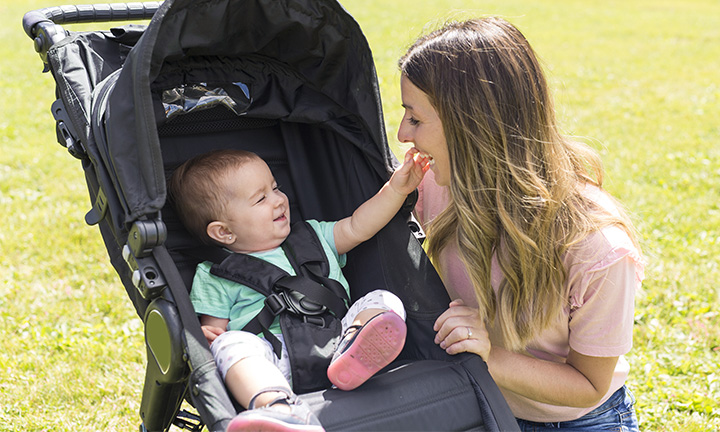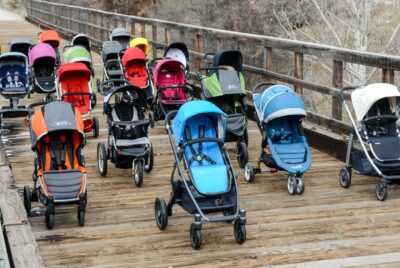Baby Stroller age and weight limits: Guidelines for when to switch Baby Strollers

As a parent, choosing the right stroller for your child’s age and weight is crucial to ensure their safety and comfort during outings. Strollers are designed with specific age and weight limits in mind, and understanding these age and weight limits for baby strollers. Our guidelines help you choose a stroller that ensures your child’s safety and comfort. Visit now! will help you make informed decisions about when to switch strollers.
Introduction
Strollers are an essential tool for parents, allowing them to conveniently transport their little ones while providing a comfortable and secure environment. However, it’s important to remember that strollers are not one-size-fits-all and have specific age and weight limits that must be considered. In this article, we will explore the importance of stroller age and weight limits and provide guidelines to help you determine when it’s time to switch to a new stroller.
Why are stroller age and weight limits guidelines important?
Stroller age and weight limits serve several important purposes. Firstly, they ensure the safety of your child. Strollers are designed to support a certain amount of weight and provide appropriate harness systems to keep your child secure. By adhering to these limits, you can avoid potential accidents or injuries caused by exceeding the stroller’s capacity.
Secondly, stroller age and weight limits are related to your child’s comfort. As your child grows, their size and developmental needs change. A stroller that is too small or lacks the necessary features for an older child may cause discomfort or restrict their movement. By transitioning to a stroller suitable for their age and weight, you can provide a more enjoyable experience for your child.
Understanding stroller age and weight limits guidelines
Stroller age and weight limits can vary depending on the specific model and brand. It’s important to consult the manufacturer’s guidelines for the stroller you own or plan to purchase. However, there are general principles that apply to most strollers.
Age limits guideline
Infant strollers are designed for newborns and infants up to a certain age. These strollers typically feature a fully reclining seat or compatibility with a car seat, allowing you to use them from birth. As your child grows older and gains more head and neck control, you can consider transitioning to a stroller with a more upright seating position.
Umbrella strollers are lightweight and compact, making them suitable for older infants and toddlers. These strollers usually have a minimum age requirement of around six months when babies can sit up on their own without assistance.
Jogging strollers are designed for active parents who want to maintain their exercise routines while spending time with their child. These strollers often have a minimum age limit of around eight months due to the increased stability and support required for jogging or running.
Convertible strollers offer versatility and can adapt to your child’s changing needs. They usually have a wider age range and weight limit, allowing you to use them from infancy to toddlerhood.
Weight limits guideline
Strollers also have weight limits that indicate the maximum amount of weight they can safely carry. It’s important not to exceed these limits as it can compromise the stroller’s stability and structural integrity. Weight limits typically range from 30 to 50 pounds, depending on the stroller type.
Guidelines for Choosing the right stroller for your child’s age and weight
Selecting a stroller appropriate for your child’s age and weight is crucial for their safety and comfort. Here are some popular stroller types and their suitability based on age and weight:
Infant strollers
Infant strollers, also known as travel systems, are designed for newborns and younger infants. These strollers often come with a car seat that can be attached to the stroller frame, allowing you to easily transition your baby from the car to the stroller without disturbing their sleep. The age range for infant strollers is typically from birth to around nine months, depending on the specific model. It’s important to check the weight limit of the car seat and stroller to ensure your child falls within the recommended range.
Umbrella strollers
Umbrella strollers are lightweight, compact, and easy to maneuver, making them ideal for older infants and toddlers. They usually have a minimum age requirement of around six months when babies can sit up unassisted. Umbrella strollers have weight limits ranging from 30 to 50 pounds, providing ample support for toddlers and small children.
Jogging strollers
Jogging strollers are designed for parents who enjoy jogging or running and want to bring their child along. These strollers have features such as larger wheels, suspension systems, and a fixed front wheel for improved stability during physical activities. Due to the increased support and stability required, jogging strollers often have a minimum age limit of around eight months. It’s essential to choose a jogging stroller that can accommodate your child’s weight within the specified range.
Convertible strollers
Convertible strollers offer flexibility and can adapt to your child’s changing needs. These strollers can be used from infancy to toddlerhood and often have a higher weight limit compared to other stroller types. They typically have reversible seats, allowing your child to face you or the world. Convertible strollers are a popular choice for parents who want a long-term investment that can grow with their child.
Signs that your child has outgrown the stroller guideline
Knowing when it’s time to switch strollers is essential to ensure your child’s comfort and safety. Here are some signs that indicate your child has outgrown their current stroller:
Difficulty fitting in the stroller: If your child’s head, legs, or body appear cramped or extended beyond the stroller’s boundaries, it’s a clear sign that they have outgrown the stroller.
Safety concerns: If your child’s weight exceeds the stroller’s weight limit, it can compromise the stroller’s stability and increase the risk of accidents or tip-overs. It’s important to transition to a stroller that can accommodate your child’s weight safely.
Your child’s comfort: If your child appears uncomfortable or complains during stroller rides, it may be a sign that they have outgrown the stroller. Older children may need more space, a higher seatback, or additional legroom for optimal comfort.
A guideline for Transitioning to a new stroller
When the time comes to switch to a new stroller, it’s essential to consider your child’s age, weight, and specific needs. Here are some steps to guide you through the transition process:
Researching and selecting a new stroller: Take the time to research different stroller models and read reviews to find one that suits your child’s age, weight, and lifestyle. Consider factors such as safety features, maneuverability, storage capacity, and comfort.
Adjusting to the new stroller: Once you have selected a new stroller, give your child time to adjust to the change. Allow them to explore and familiarize themselves with the new stroller gradually. It’s normal for them to take some time to feel comfortable and secure in the new stroller.
Guidelines for Stroller safety tips
To ensure the safety of your child while using a stroller, follow these important safety tips:
Regularly inspect your stroller: Check for any signs of wear and tear, loose screws, or broken parts. Make sure all the mechanisms, such as brakes and harnesses, are functioning properly.
Follow the manufacturer’s guidelines: Read and understand the manufacturer’s instructions and safety guidelines for your specific stroller model. This will help you use the stroller correctly and ensure your child’s safety.
Secure your child properly: Always use the stroller’s harness system and make sure it is correctly fastened to keep your child secure during rides. Avoid hanging heavy bags or items on the stroller’s handles, as it can affect its balance.
Conclusion to Stroller age and weight guidelines
Choosing the right stroller for your child’s age and weight is crucial for their safety and comfort. By understanding stroller age and weight limits, you can make informed decisions about when to switch strollers. Remember to consider signs that indicate your child has outgrown their current stroller and follow the necessary steps to transition to a new one. By following safety guidelines and regularly inspecting your stroller, you can ensure a pleasant and secure experience for you and your child.
FAQs about stroller age and weight guidelines
Q: What are stroller age and weight limits? A: Stroller age and weight limits refer to the specific guidelines set by manufacturers regarding the suitable age range and maximum weight a stroller can safely accommodate.
Q: Why is it important to follow stroller age and weight limits? A: Adhering to stroller age and weight limits ensures your child’s safety and comfort during stroller rides. Exceeding these limits can compromise the stroller’s stability and increase the risk of accidents.
Q: What are the different types of strollers available based on age and weight? A: There are various stroller types available, such as infant strollers, umbrella strollers, jogging strollers, and convertible strollers. Each type is designed to cater to specific age ranges and weight limits.
Q: How do I know if my child has outgrown their stroller? A: Signs that your child has outgrown their stroller include difficulty fitting in the stroller, safety concerns due to weight exceeding the stroller’s limit, and your child’s discomfort during rides.
Q: What should I consider when transitioning to a new stroller? A: When transitioning to a new stroller, consider your child’s age, weight, specific needs, and lifestyle. Research different stroller models and select one that best suits your requirements.

